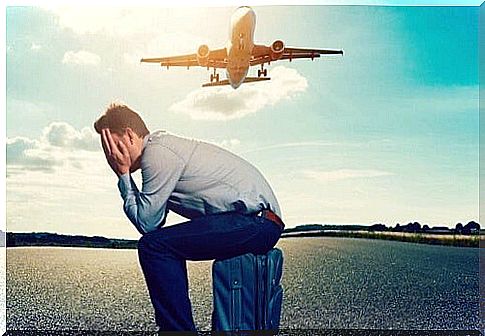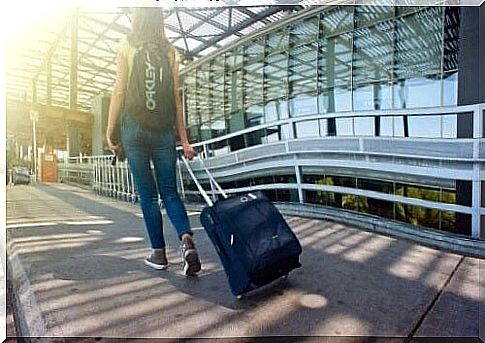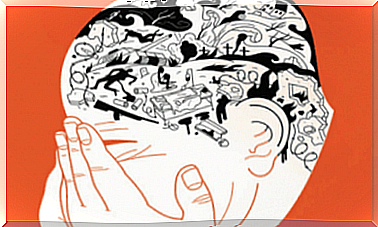Odophobia: The Fear Of Traveling

Restlessness when you have to get away from home, from your city and from everything you know and feel safe. Anguish at the very idea that something might happen while we are away from home. Dizziness, sweating and tachycardia when you get on a train or a plane … As disconcerting as it may seem, odophobia, or the fear of traveling, is a disorder that can undermine the quality of life of the person who suffers from it.
Most of us associate travel with an enriching experience and can’t wait to embark on one. Getting away from the daily grind and discovering new places is a powerful stimulus for many. Yet this is not the case for everyone. There are also those who feel a real panic in abandoning their securities, as is the case with those suffering from odophobia. And in some cases, travel is an obligatory event, whether for work or family reasons.
The anxiety experienced in these situations is extremely disabling and even limiting. Phobias, however bizarre and strange they may appear to those who do not suffer from them (or do not understand them), can be devastating for the person who experiences them on their skin.

Odophobia, the fear of traveling: symptoms, causes and therapeutic strategies
Odophobia has accompanied the human being since the dawn of time. Not everyone is happy to leave their comfort zone. Taking certain means of transport and reaching places that are unknown and beyond one’s control causes agitation, concern and fear.
In this case we are faced with a particular type of phobia, classified in the Diagnostic and Statistical Manual of Mental Disorders (DSM-5). An irrational and paralyzing fear, capable of limiting various social, personal and working aspects of the individual.
Nonetheless, odophobia is experienced differently depending on the individual. There are those who are afraid of means of transport, those of the idea of being away from home or of dealing with an unknown environment. Obviously, many are experiencing all three dimensions together.
It may seem strange that a person does not like to travel, yet he could suffer from odophibia and it is an aspect to be taken into consideration. Phobias affect 1 in 23 human beings. In fact, they represent the most common psychiatric disorder and, more or less, suffer from a sort of limiting anxiety.
What are the symptoms?
Like all phobias, odophobia also manifests itself with rather heterogeneous emotional, cognitive and physical symptoms. Let’s see the most common.
Emotional manifestations
- Fear of getting on any means of transport that can take us away from home.
- Feeling that something bad might happen during the trip.
- Feeling anguish at the idea of abandoning one’s securities.
- Feeling ashamed of sharing the problem with others.
Cognitive symptoms
- Inability to take charge of the aspects concerning the journey, thoughts accumulate and one remains paralyzed once one arrives at the airport or station.
- Imagine the most adverse situations: accidents, getting lost once you reach your destination, being robbed, not finding the hotel, etc.
- Being obsessed with having to travel.
- Confusional state and mental block.
Physical symptoms
- Dizziness.
- Stomach pain and intestinal disorders.
- He retched.
- Tachycardia.
- Sweating.
- Any panic attacks.
What are the causes of odophobia?
Knowing the cause behind a phobia is somewhat difficult. Studies such as those carried out at the Neuroscience Institute of La Timone (France) indicate that, in general, these disorders tend to manifest themselves in two ways:
- Phobias of traumatic origin. In the case of odophobia, it could be the result of a bad experience, such as having been the victim or witness of a terrorist attack on a previous trip.
- Without a specific trigger event (non-specific phobias). In most cases, however, genetic, family, environmental, or developmental factors come into play.

What is the treatment for odophobia?
Odophobia is often associated with other phobias, such as the fear of flying. In the most extreme cases it can also coexist with agoraphobia. However, it is generally linked to generalized anxiety disorder (GAD).
It is therefore easy to come across complex and extremely particular situations, which is why an accurate diagnosis is essential. Regarding the therapeutic approach, it is advisable to adopt a multidimensional approach.
On the one hand, the administration of some psychotropic drugs such as anxiolytics may prove useful. On the other hand, psychotherapy is useful in all cases and in particular through the following strategies:
- Progressive exposure to phobic stimuli. Exposure therapy consists of introducing the subject to the stimuli that cause him anxiety so that he learns to manage his emotions and thoughts. This technique is more effective when combined with cognitive-behavioral therapy.
- Cognitive restructuring, aimed at countering the catastrophic ideas typical of subjects affected by ophobia.
- Relaxation and breathing techniques.
It is important to never underestimate your fears, especially when they begin to limit different aspects of your life. Phobias are the result of an anxiety disorder that requires therapeutic intervention.









